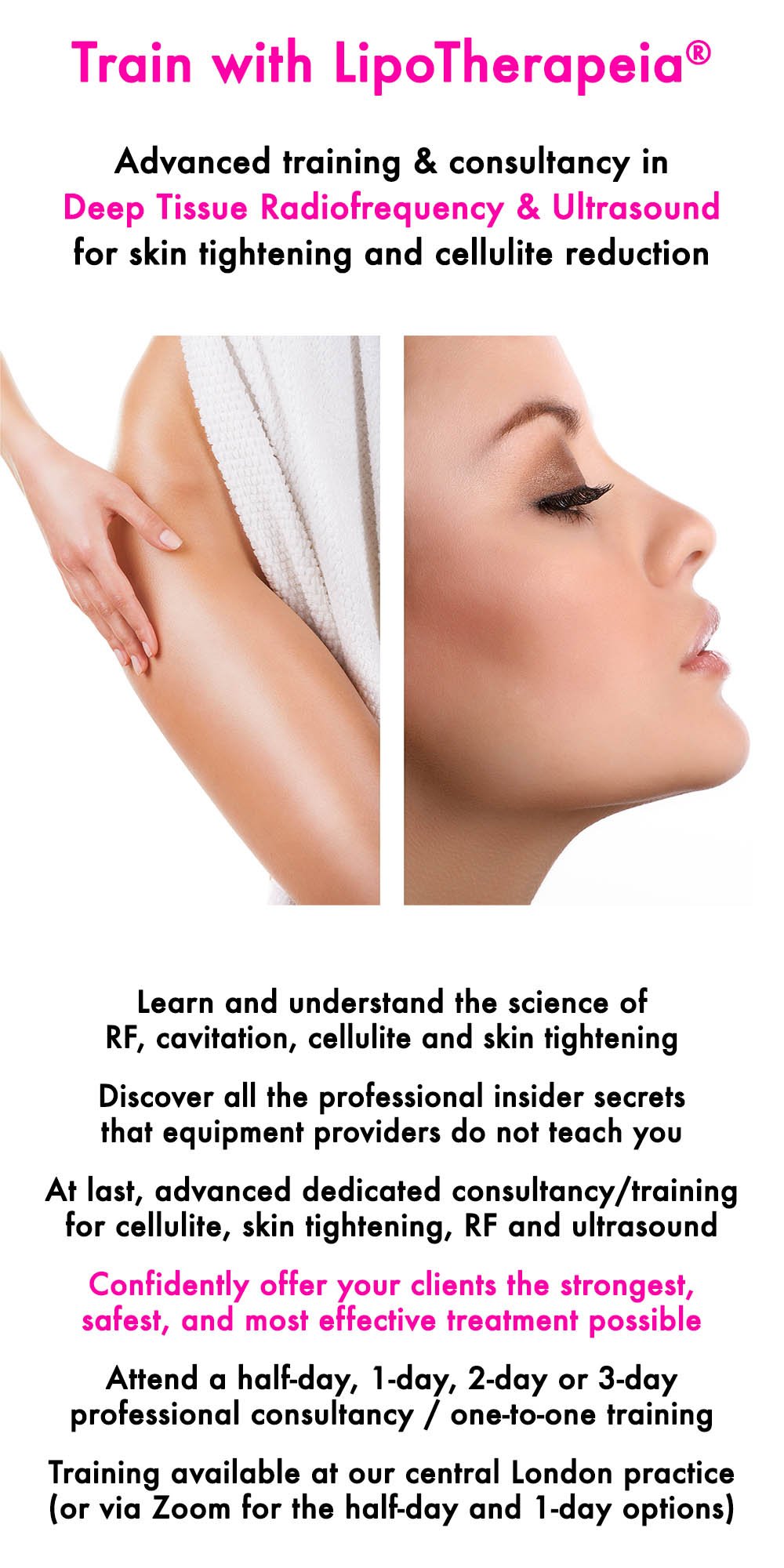“TL;DR: Dairy foods can indirectly cause cellulite via both saturated fat content or lactose / dairy intolerance.
However, it is when dairy is combined with fat, sugar, starch and alcohol that it has a serious impact in relation to cellulite development.”
Milk, cream, butter, yoghurt and cheese: do they cause cellulite?
Do dairy foods cause cellulite?
(Saturated) fat in dairy products and cellulite
Dairy/lactose intolerance and cellulite
Dairy + Sugar + Starch + Fat + Alcohol
Have a skin tightening/cellulite treatment in London with the experts
Discover our professional training and consultancy in cellulite, skin tightening, radiofrequency and ultrasound
Do dairy foods cause cellulite?
There are two things about the consumption of dairy foods and the development of cellulite:
Saturated fat (and fat content in general), which contribute to calorie load
Dairy intolerance, which can cause bloating, water retention and low grade, whole body inflammation
For most of the population, dairy foods are not as an important cellulite contributing factor as starches, sugar, fried food or alcohol, but for some they are indeed an important cause of cellulite.
Let’s have a look.
(Saturated) fat in dairy products and cellulite
Excess fat in take, especially saturated fat, can result in triglyceride (fat) accumulation in the adipocytes (fat cells), including those of the hypodermis (deepest skin layer), where cellulite is found.
The most important contributing factor to such fat accumulation is cheese, cream and butter, as most people do not tend to consume enough milk or full fat yoghurt to make a significant difference, fat-wise.
Indeed, heavy sauces based on butter and cream should be avoided, as excessive consumption of cheese.
Usually the above food products are also combined with starches, other fatty foods, alcohol and sugar, and that combination is definitely a “cellulite bomb” ready to detonate. Examples include:
Bread, butter and jam (carbs, fat and sugar)
Cheese and wine (fat and alcohol)
Cheese and jam/chutney (fat and sugar)
Cheese-pie (fat and carbs)
Pizzas, especially American style pizzas (fat and carbs)
Croissants, muffins, cakes, cookies, ice cream, milk chocolate and almost all desserts and baking products (fat, carbs and sugar)
Fatty meat cooked with a cream based sauce (fat and fat)
Melted butter on top of a fatty steak (fat and fat)
Toasted cheese sandwich (fat and carbs)
French toast (fat and carbs)
Pasties (fat and carbs)
Afternoon tea (fat, sugar and carbs galore)
To be honest, the examples are endless.
Of course, nobody said that we should never consume those foods - moderation is always the key. But minimising them will help prevent or reduce cellulite.
After all, our life is all about choices. We can choose to indulge too much and have more cellulite (which doesn’t kill, so no reason to reason to stress about it). Or we can choose to indulge only occasionally and have less cellulite or none at all.
One last note: saturated fat is not the best thing for cellulite or overall health. However, replacing saturated fats (i.e. cream, butter) with trans/hydrogenated fats (i.e. horrible margarine) in pasties, pastries etc is even worse. Plus all types of fat contain the exact same amount of calories. So the fact that your croissant is not all-butter does not mean it is better for you - quite the contrary.
Dairy/lactose intolerance and cellulite
A little known fact is that dairy foods can cause intolerance not just due to lactose but also due to the proteins in milk, both the whey and the casein fraction.
Furthermore, contrary to popular wisdom, not all lactose in metabolised by probiotics during the yoghurt or kefir making process. A lot of lactose remains and can be a cause of intolerance.
Dairy / lactose intolerance can result in gastrointestinal symptoms, water retention and low grade inflammation, all of which can contribute towards cellulite, indirectly.
And finally, casomorphin, a gut metabolite of casein can attach to opioid receptors and cause sleepiness.
Dairy + Sugar + Starch + Fat + Alcohol = cellulite
So, in combination, dairy can contribute to cellulite directly (via fat in cheese, cream, butter and full-fat yoghurt) and indirectly (via whey, casein or lactose intolerance).
However, the way in which dairy can become really problematic for cellulite is when combined with fat, sugar, starches and alcohol, es described above.
Have a cellulite treatment in London with the experts
At LipoTherapeia we have specialised 100% in skin tightening and cellulite reduction for more than two decades and 20,000+ sessions.
This is all we study and practise every day and have researched and tried hands-on all the important skin tightening equipment and their manufacturers.
As strong, deep acting radiofrequency and deep-acting, high-power ultrasound cavitation are the technologies of choice for skin tightening and cellulite reduction, we have invested in the best RF/ultrasound technologies in the world.
Furthermore, over the last two decades we have developed advanced RF and cavitation treatment protocols in order to make the most of our technologies, for maximum results, naturally and safely.
Our radiofrequency/ultrasound treatments are comfortable, pain-free, downtime-free, injection-free, microneedling-free, 99.5%+ safe and always non-invasive.
And our focus is on honest, realistic, science-based treatment, combined with caring, professional service, with a smile.
We will be pleased to see you, assess your cellulite, skin laxity or fibrosis, listen to your story, discuss your case and offer you the best possible treatment.
Learn more or check prices and book an expert treatment at our London clinic (49 Marylebone High Street, W1)
Discover our professional training in cellulite, skin tightening, radiofrequency and ultrasound
Do you want to deeply understand radiofrequency, ultrasound cavitation, cellulite and skin tightening?
Attend a half-day, 1-day or 2-day or 3-day professional consultancy / one-to-one masterclass and confidently offer your clients the safest, strongest and most effective treatment possible.
Service available via Zoom or at our central London practice.




![How to get rid of cellulite | 111 tips from the experts [2024 update]](https://images.squarespace-cdn.com/content/v1/5294cad9e4b009e918124a61/1582205124442-U31A5ECGNCG62VFPPJWJ/How+to+get+rid+of+cellulite+in+2020.jpg)


